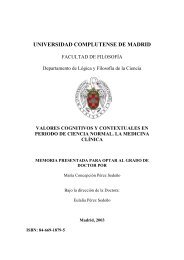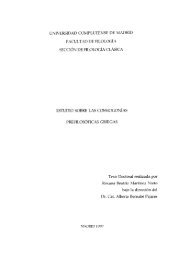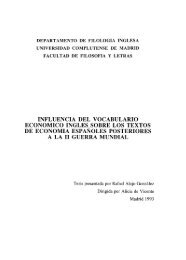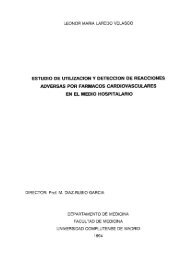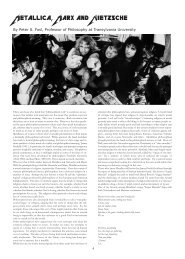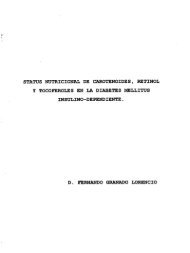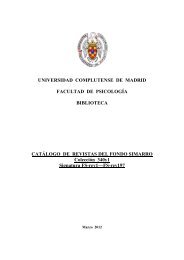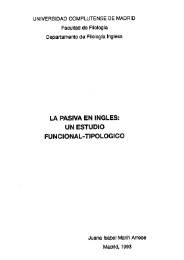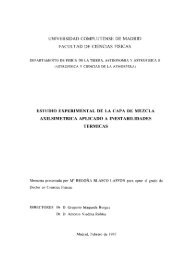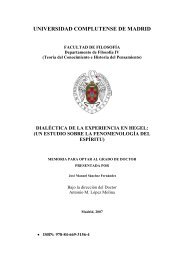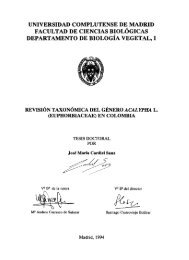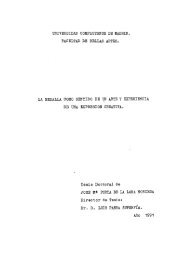liiiMIIIfl~UDliiiMIII~U - Biblioteca de la Universidad Complutense ...
liiiMIIIfl~UDliiiMIII~U - Biblioteca de la Universidad Complutense ...
liiiMIIIfl~UDliiiMIII~U - Biblioteca de la Universidad Complutense ...
You also want an ePaper? Increase the reach of your titles
YUMPU automatically turns print PDFs into web optimized ePapers that Google loves.
lyzed by acetyl-CoA earboxy<strong>la</strong>se (7, 10, 11). Durirag the<br />
past few years, a novel meeharaism of sbort-term control<br />
of hepatie CPT-I has beera put forward [reviewed<br />
ira Ref. (7)]. Several studies using permeabilized hepatocytes<br />
have showra that various agerats exert shortterm<br />
effects ora CPT-I activity ira parallel witb charages<br />
ira the rate of long-chaira fatty acid oxidation measured<br />
ira Ihe same celí preparatioras. Thus, cAMP araalogs<br />
(e.g., dibutyryl-cAMP) (12), effectors that marease iratracellu<strong>la</strong>r<br />
cAMP leveis (e.g., glucagora arad forskolin)<br />
(12), arad proteira phosphatase inhibitors (e.g., okadaic<br />
acid) (18) are able to stimu<strong>la</strong>te hepatia CPT-I, whereas<br />
Ca 2~-mobilizirag agerats (e.g., vasopressira, a 1-adreraergie<br />
agoraists, arad extracellu<strong>la</strong>r ATP) irahibit hepatia<br />
CPT-I (14). Sirace these short-term changes ira CPT-I<br />
activity are very stable arad survive complete removal<br />
of malonyl-CoA from the medium, they are assumed to<br />
be mediated by a malorayl-CoA-ira<strong>de</strong>pera<strong>de</strong>rat mataraism<br />
which might iravolve phosphory<strong>la</strong>tiora of putative<br />
mediator protein(s) (7, 16).<br />
I<strong>de</strong>ratificatiora of physiological substrates of AMPK<br />
has beera bampered by the <strong>la</strong>ek of specific methods for<br />
aetivatirag tbe kiraase ira iratací celís. AMPK was routiraely<br />
activated ira iratact hepatocytes by incubatiora<br />
witb fructose or by heat shock or arseraite [cf. Ref. (1)].<br />
These treatments alí <strong>de</strong>plete iratracellu<strong>la</strong>r ATP arad,<br />
tberefore, bave rraaray noraspecifie si<strong>de</strong> effects. However,<br />
a more specific melbod for activatirag AMPK ira iratact<br />
celís has beera receratly reparted. Incubation of intaet<br />
hepatocytes with 5-amiraoimidazole-4-carboxami<strong>de</strong> riboraucleosi<strong>de</strong><br />
(AICAR) causes uptake of this componrad<br />
arad subsequerat accumu<strong>la</strong>tiora withira the cefi of its<br />
moraophospbory<strong>la</strong>ted form, 5-amiraoimidazole-4-carboxami<strong>de</strong><br />
ribonucleosi<strong>de</strong> moraophosphate (ZMP) (16).<br />
The <strong>la</strong>tíer has been showra to mimie the effect of 5’-<br />
AMP ora allosterie activatiora ofrat liver AMPK without<br />
cbaragirag tbe levels of ATP, ADP, arad AMP withira tbe<br />
hepatoeyte (16, 17). Thus, exposure to AICAR has beera<br />
showra lo inactivate acetyl-CoA carboxy<strong>la</strong>se arad 3-hydroxy-8-methylglutaryl-CoA<br />
reduetase ira iso<strong>la</strong>ted hepatocytes<br />
(8, 17) as well as hormone-serasitive upase ira<br />
iso<strong>la</strong>ted adipocytes (18). Ira the preserat repod we show<br />
that activation ofAMPK produces a stimu<strong>la</strong>tiara ofhepatie<br />
long-chaira fatty acid oxidatiora, which relies ira<br />
turra ora activatiora of CPT-I by malorayl-CoA-<strong>de</strong>pera<strong>de</strong>rat<br />
arad ira<strong>de</strong>pera<strong>de</strong>nt mecharaisms.<br />
MATERIAIS AND METHODS<br />
4ClPalmitie acid, LL-’4C]octanoic acid, L-[Me-’4C]carnitine.<br />
Materia/a. rl-’4C<strong>la</strong>cetyl-CoA. L1-’ and 3H,O were supptied hy Amersham<br />
International (Amersham, Bucks, UK). Digitonin, col<strong>la</strong>gerarase (type<br />
1), AICAR. ZMP, 5-AMP, arad taxol were purchased froin Sigma<br />
Chemical Co. (St. Lorais, MO). Okadaic acid wras supplied by Calbiochem<br />
(San Diego, CA). Tetra<strong>de</strong>cylglycidic acid was a kirad gift from<br />
Dr. J. Nl. Lowensteira (Brara<strong>de</strong>is University, Wraltham, MA).<br />
VELASCO ET AL.<br />
Hepatocyte iso<strong>la</strong>tion and incubation. Malo Wistar rats (250—300<br />
g) which had free acceas to food arad water were used throughout in<br />
this study. l-Iepatocytes ‘vero iso<strong>la</strong>ted by the col<strong>la</strong>genase perfusiora<br />
method <strong>de</strong>scribed ira Ref. (19). Because lipogenesis is markedly <strong>de</strong>pressed<br />
just after hepatocyte iso<strong>la</strong>tion, celia were incubated for 15<br />
mio at 37~C ira a gyratory metabolic shaker arad subsequently filtered<br />
through nylon mesh prior to use (20). Celí viability, as <strong>de</strong>termined by<br />
trypan blue exelusiora, always excee<strong>de</strong>d 95% in the final hepatocyte<br />
suspension.<br />
Hepatocytes were incubated irn Krebs—Heraseleit bicarbonato<br />
bulfer supplemented with 10 mM glucose and 1% (w/v> <strong>de</strong>fatted and<br />
dialyzed bovino serum albumin. Incuhatioras (4—6 mg of cellu<strong>la</strong>r proteira/mí)<br />
were perforined ira a total volume of 2 ml at M’C, with<br />
constant shakirag (85 oscil<strong>la</strong>tiona/min) arad un<strong>de</strong>r an atinosphere of<br />
0<br />
2/C02 (19:1). Stock solutiona ofAICAR, okadaic acid, arad taxol were<br />
prepared in Me2SO. Therefore, control incubatioras had the corresponding<br />
Me,SO coratent. No significarat irafluence of Me2SO on any<br />
of the experira,eratally <strong>de</strong>termined parametera was observed at the<br />
final coracentration used (0.1%, y/y).<br />
Rete offatty acid oxidation. For <strong>de</strong>tern,inatiora ofthe rate of fatty<br />
acid oxidatiora, hepatocytes were incubated for 15 mm with the cellu<strong>la</strong>r<br />
effectors iradicated in every case. Reactiona 4C]fatty were subsequently acid (either<br />
started palmitate by the or octanoate, addition to0.05 celí incubátioras Ci/mol, 0.5 of nn¡ L1-’ final coracentration)<br />
bourad to albura,in. Afrer 10 mm, renetions were stopped with 0.5 ml<br />
of 2 M perchlorie acid and oxidation producta were extracted arad<br />
quaratified exactly as <strong>de</strong>scribed before (13). Total oxidatiora producta<br />
were calcu<strong>la</strong>ted ras the Sun, of acid-soluble producta and CO,. Acidsoluble<br />
producta (mostly ketone Sodios) routinely accounted for 90—<br />
95% of total oxidation producta (18):<br />
CPT-I assay. Tho activity of CPT-I was <strong>de</strong>termiraed ras the tetra<strong>de</strong>cylglycidate-sensitive<br />
incorporatiora of radio<strong>la</strong>beled t-carnitirae<br />
into palmitoylcarnitine by four difi’erent methods (A, B, C, and O).<br />
fn brief, hopatocytes woro preiracubated for 20 mira in the abserace or<br />
In the presence of 10 pM tetra<strong>de</strong>cylglycidate, a apecifie irreversible<br />
inhihitor of CPT-I (13, 21). Incubationa were coratinued for an additional<br />
15-mira period ira the presenee of the collu<strong>la</strong>r elYectors indicated<br />
In every case. Subsequently, aliquota were removed from the incubatioras<br />
to monitor CPT activity with the four differeat types of assay.<br />
In methods A arad B, CPT activity was measured ira digitoninpernicabilized<br />
hepatocytes. Both methods were performed using the<br />
sanie <strong>de</strong>tergerat/cell proteira ratio (about 40 pg digitonin/nig ceIlprotein).<br />
Enzyme activity was routiraely <strong>de</strong>tennined by method A (“onostep<br />
assay”). Ira this method, 100 pl of hepatocyte suspensiora <strong>la</strong> diroctly<br />
ad<strong>de</strong>d te 100 pl of prowarmed digitorain-containirag assay mediun,<br />
exactly as <strong>de</strong>scribed ira Rol. (13). Renco, monitorirag ofenzyn,e<br />
activity is perforzraed imn,ediately upora permeabilization of the celís<br />
(13, 22). In method 3 (“two-atep assay”), hepatocytea are permeabilized<br />
arad thoroughly washed prior to <strong>de</strong>tern,inatiora of erazynxe activity.<br />
Thus, 1.0 ml of hepatocyte susperasion was permeabilized with<br />
0.20 mg of digitorain dissolved ira 1.0 ml of 5 mp.x Tris—HCI (pH 7.4),<br />
50 mM RE, 100 m¿ KCI, 2.5 mM EDTA, arad 2.5 mr¿ BOTA (F<br />
mediumí. The resultirag mix was gently shaken for 5 s and rapidly<br />
diluted by tranafer Lo trabes coratainirag 40 ml of ice-cold F~ medium.<br />
Cotí ghosts were sodimoratod by centrifugation at 350g for 15 a, and<br />
pellota were taken up ira 1.0 ml of prewarnied F mediuni. The resultirag<br />
susperasiona of coll ghosts were incubatod at 370C for 5—15<br />
mira and thon CPT activity was moraitored (15).<br />
Ira method C, CPT activity was measured ira sonicated hopatoeytos.<br />
Celís were sedimoratod by low-apeed centrifugatiora (50g, 2 mira). The<br />
celí peltet was resuspora<strong>de</strong>d ira F medium arad soraicated for two<br />
periods of 10 a while beirag cooled in ico/water. Saniples of soraicated<br />
proparations were used for <strong>de</strong>tern,inatiora of CPT activity (15).<br />
Jo method D. CPT activity was measurod ira mitochoradria iso<strong>la</strong>ted<br />
from hepatocyto suspensioras exactly as <strong>de</strong>scribed before (15). Preparatioras<br />
of mitochondria were practically <strong>de</strong>void of peroxisomes, as



